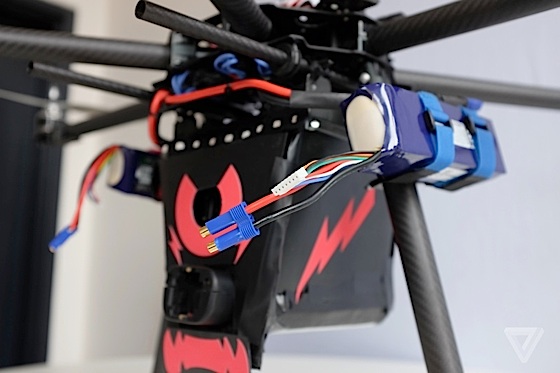Shouting at strangers to get off your lawn as you menacingly wave a crumbled newspaper is a thing of the past; in the near future, you’ll be sending stun-gun carrying drones after them. CUPID, short for Chaotic Unmanned Personal Intercept Drone, is an app-controlled six-pronged-copter flying drone that packs an 80,000-volt Taser dart ― legally surpassing policemen’s 50,000-volt Tasers.

The drone was first revealed at the SXSW Interactive Festival in Austin, TX, as a future security concept. It is the brainchild of Austin-based mobile software design studio Chaotic Moon. The drone is approximately the same size as a traditional hexacopter-style drone, but houses a more complex technology in the form of its stun-gun, facial recognition, tracking device, and autopilot.
The biggest design challenge was not actually automating all those systems, but protecting the core technology against the electromagnetic pulse that results as a byproduct when harnessing as much electricity as 80,000 volts. A stray EMP would instantly shut off the machine, sending it crashing down as soon as it fires the dart. The issue was rectified by surrounding all electronic elements in a Faraday Cage, a conductive enclosure that blocks electrical fields.

As an added benefit, any electronics within the vicinity of the EMP blast would also fry, adding in the extra annoyance of not only disabling trespassers, but also destroying their expensive gadgets. So if you plan on filming CUPID in action as reporters from The Verge did, CUPID’s chief designer, William “Whurley” Hurley, will require you stand at least five feet away.
Real-life application
Whurley’s ideal use for CUPID is simple: Once an intruder is spotted on a property, CUPID will fly over and transmit an image of their face. If the property owner does not grant clearance, then CUPID will issue an audio warning before tazering any uncompliant persons into submission, then wait the authorities to arrive.
Integrating these features is simple, Whurley assures The Verge, but CUPID was actually constructed as a publicity stunt to attract coverage, rather than a prototype for future production. Technology isn’t the challenge, he argues, but the politics is. Whurley believes that there’s definitely an element of future-shock surrounding the use of what is basically a flying, electrocuting robot; conducting demonstrations of tech in action is key in dispelling people’s fears of what could otherwise be a life-saving technology. Why send police officers into the location of an armed perpetrator when a robot could do the same, without jeopardizing the offcers’ lives?
Story via Verge
Advertisement
Learn more about Electronic Products Magazine





